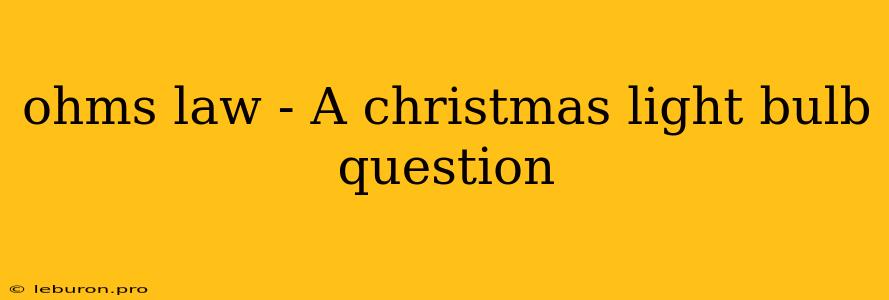The holiday season is upon us, and with it comes the joy of decorating our homes with twinkling Christmas lights. But have you ever stopped to wonder how these lights work? The magic behind their glow is rooted in a fundamental principle of electricity: Ohm's Law. This law governs the relationship between voltage, current, and resistance, and it helps us understand how Christmas lights, and many other electrical components, function. Let's delve into this fascinating concept and explore how it applies to a classic holiday question: what happens when a single bulb in a string of Christmas lights burns out?
Ohm's Law: The Foundation of Electrical Circuits
Ohm's Law is a foundational principle in electrical engineering that describes the relationship between voltage, current, and resistance in a circuit. It states that the current (I) flowing through a conductor is directly proportional to the voltage (V) applied across its ends and inversely proportional to the resistance (R) of the conductor. Mathematically, this relationship is represented as:
I = V/R
- Voltage (V) is the electrical potential difference between two points in a circuit, measured in volts (V). It represents the "push" or "force" that drives the flow of current.
- Current (I) is the flow of electrical charge through a conductor, measured in amperes (A). It represents the rate at which electric charge flows.
- Resistance (R) is the opposition to the flow of current, measured in ohms (Ω). It determines how much the conductor resists the flow of charge.
Understanding Christmas Lights: A Series Circuit
Most Christmas lights are connected in a series circuit, where the bulbs are arranged one after the other, forming a single path for the current to flow. This configuration has some important implications:
- Single Path: If the current encounters any interruption in the circuit, such as a burnt-out bulb, the entire circuit is broken.
- Shared Voltage: The total voltage across the circuit is divided equally among all the bulbs in the series.
- Current Remains Constant: The current flowing through each bulb is the same, regardless of the bulb's individual resistance.
The Impact of a Burnt-Out Bulb
When a bulb in a series Christmas light string burns out, it essentially breaks the circuit, preventing the flow of current. This occurs because the filament inside the burnt-out bulb has broken, creating an infinite resistance. Here's why the entire string goes dark:
- Circuit Interruption: Since the current can no longer flow through the broken filament, it cannot reach the remaining bulbs in the string.
- No Voltage Drop: With the circuit broken, the voltage drop across the burnt-out bulb becomes zero.
- No Current Flow: As a result, no current can flow through the remaining bulbs, causing them to go dark.
The Solution: Parallel Circuits and Modern Lights
The problem of a single burnt-out bulb disabling the entire string is a drawback of series circuits. To overcome this issue, many modern Christmas lights are designed with parallel connections.
- Parallel Connections: In a parallel circuit, each bulb has its own independent path for the current to flow.
- Independent Bulbs: If one bulb burns out, the other bulbs remain lit because the current can still flow through their individual paths.
- Constant Voltage: Each bulb receives the full voltage of the circuit, ensuring that they all operate at their intended brightness.
Applying Ohm's Law to Christmas Lights
Ohm's Law can be used to analyze the behavior of Christmas lights and understand how they function. For example, let's say you have a string of 50 Christmas lights connected in series, operating at 120 volts. If each bulb has a resistance of 10 ohms, you can calculate the total resistance, current, and power of the circuit:
- Total Resistance: R_total = R_bulb * number of bulbs = 10 Ω * 50 = 500 Ω
- Current: I = V / R_total = 120 V / 500 Ω = 0.24 A
- Power: P = V * I = 120 V * 0.24 A = 28.8 W
This demonstrates how Ohm's Law helps us determine key characteristics of a circuit, such as the current flowing through it and the power consumed by the bulbs.
Conclusion
The seemingly simple twinkling of Christmas lights is actually a complex interplay of electrical principles, particularly Ohm's Law. Understanding how Ohm's Law governs the behavior of these lights helps us appreciate the underlying science behind this holiday tradition. From the way bulbs are connected in series or parallel circuits to the impact of a burnt-out bulb on the entire string, Ohm's Law provides a framework for analyzing and understanding the workings of Christmas lights.
